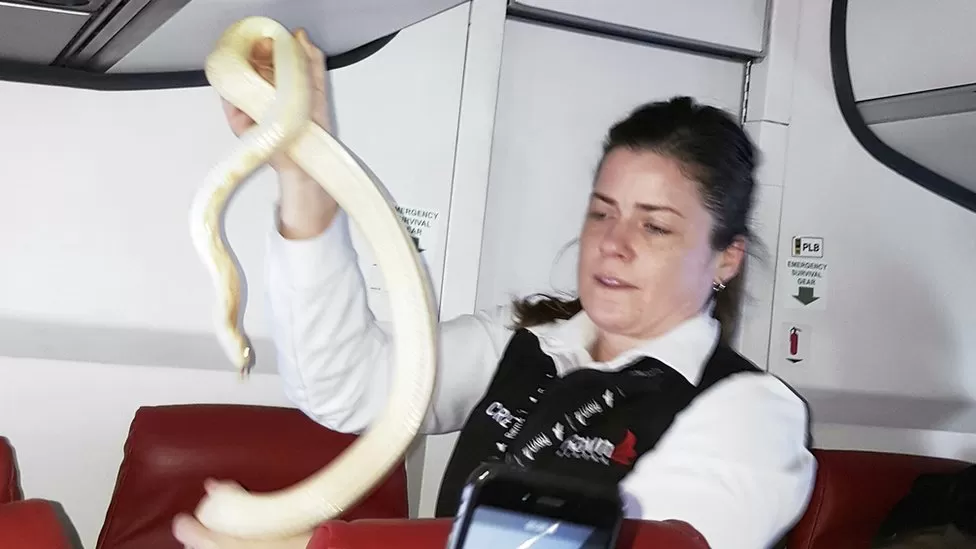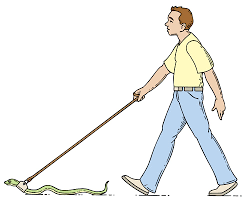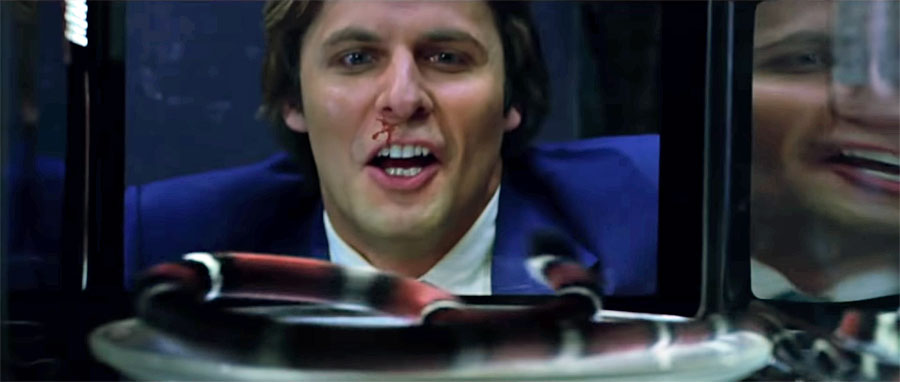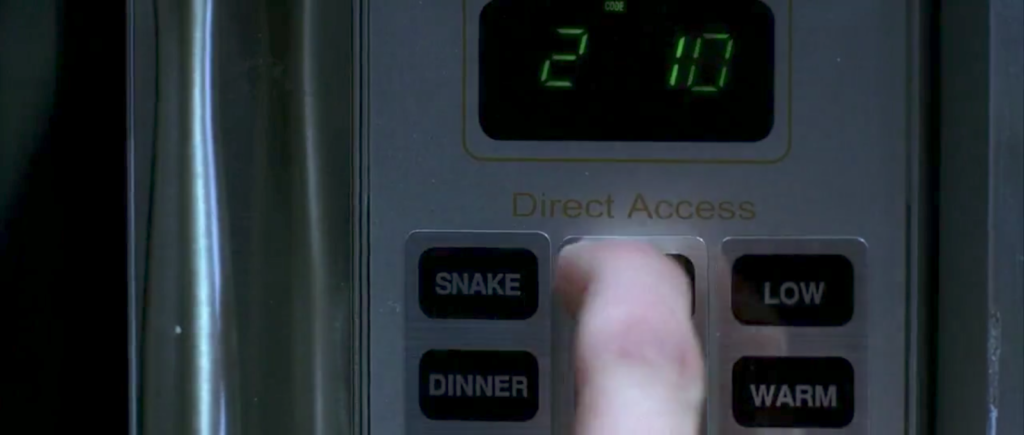‘At 30,000 feet, snakes aren’t the deadliest thing on this plane.’1

From the taglines to the soundtrack, Ellis’ 2006 action-horror film depicts a sensationalised binary between humankind and snakes. Whilst the cold-blooded creatures are undeniably presented as hostile antagonists driven by instinct, the abundance of human violence amplifies the capacity of humankind to commit unnecessary immoral acts. Consequently, the macabre representation of hostile hierarchical human-animal relations within the film highlight the detrimental impacts of animal exploitation. Framed within a violent narrative of confinement, Snakes on a Plane follows FBI agent Neville Flynn, played by Samuel L. Jackson, as he escorts key murder witness Sean Jones, played by Nathan Phillips, from Hawaii to Los Angeles. When a crate of snakes is purposefully released in an attempt to silence Jones, in true Jackson style, chaos and action ensue. Absurdity ultimately permeates the plot creating essential dramatised moments of comedic relief. Ellis presents the complexity of dominionship over untamable animals – depicting an exaggerated situation in which the wrongful control and exploitation of snakes positions them as victims.

The excessive violence of Man is epitomised in a particularly grotesque scene involving a microwave where the alignment of the viewer with the snake entraps them implicitly within the bloodshed which the film exploits to gain its crucial ‘shock factor.’ A panning shot from a flight attendant’s horror-stricken face down to the floor where a snake encroaches creates tension – positioning the viewer at the same height as the snake whilst at the same time establishing it as the primary antagonist of the scene. Establishing the attendant in this way highlights the snake’s imposed threat which is reinforced in the following panning shot. This shot introduces the viewer in succession to typical human fear responses, starting from the sweat on his brow, accentuated by the muted overhead lighting, to his frantically waving hands and finally to his shuffling feet. Focusing on each aspect of the attendant’s physical bodily reactions accentuates to the viewer the negative perceptions towards snakes, whilst elevating suspense and positioning the Man as a form of prey to be sized up before striking. Ultimately, the snake is depicted as stereotypically hostile and aggressive as it slithers into shot, its vivid red body holding connotations of danger. The physical actions of each character within the scene immediately establish an imbalance of power produced by the presence of fear. Our expectations are subverted when the man exhibits the first show of violence, restraining the snake under the sole of his shoe where the camera lingers as the creature coils and hisses. Focusing on the entrapment of the snake underscores the shift in power within the narrative, the snake consequently now at the mercy of the fate Man decides. This symbolic representation of the hierarchical stance humankind has towards nature is amplified through the portrayal of the animal’s struggle before the shot jolts upwards to track the man flinging the snake into a microwave. We are therefore increasingly aware of the distinctively urban setting, where technologies and man-made surroundings position the snakes as foreign in the distinctively ‘unnatural’ cabin. The setting therefore allows Ellis to amplify the melodramatic tone of the film, emphasising its fictitious nature which ultimately has the viewer focusing on the survival of the protagonist as opposed to the wellbeing of the snakes.
However, Individualising a snake in this scene, despite being positioned as the victim of Man’s horrific violence, does not necessarily encourage us to sympathise with the creatures as the comedic undertones prompt us to accept as justifiable the otherwise indigestible onslaught of graphic violence. The mise en scène with chiaroscuro lighting elevates a sense of foreboding before a comedic close-up shot depicts the man setting the microwave to the ‘snake’ setting briefly suspending the tension with a breath of absurd humour. The camera abruptly switches to within the microwave with the snake in the foreground and the man’s triumphant face framed behind glass in the background. Consequently, the viewer becomes aligned with the animal as the claustrophobic shot entraps them implicitly within the violence which the film exploits to gain its crucial ‘shock factor.’ Positioning the snake as the helpless victim of Man therefore presents the viewer with an opportunity to condemn the attendants’ violent actions due to the extreme nature of the snake’s demise. Ellis’ decision to employ humour within the film adds levity to the situation, reinforcing its lighthearted tone that attempts to conceal the otherwise abhorrent tyranny of the humans within the film.

Extradiegetic orchestral music crescendos as the snake appears to wince and writhe with the man exclaiming ‘Who’s your daddy now?’ before a grotesque shot depicting the snake exploding distances the viewer momentarily from the violence. Such a colloquial phrase, despite its playfulness, marks the restoration of the man’s dominance as the power dynamic shifts and the snake ultimately becomes an object at his disposal. Despite the events being overtly fictitious, no common-place microwave has a ‘snake setting’ and the likelihood of hundreds of snakes making it through security on a commercial flight is limited. The scene undoubtedly raises important ethical questions regarding the treatment of animals within the media and real life and how preconceived notions of power and survival affect this.

Close-up shots of the animal’s body allow us to understand its suffering inflicted entirely by Man – both the ones who unleashed them on the unsuspecting passengers and the passengers who actively attacked the snakes in fear of their own lives. This is interesting as Ellis undeniably positions the snakes as uncontrollable savage threats. The sustained tension and fear throughout demonises the snakes, pitting them as threats to be eliminated. The scene therefore perpetuates the idea that animals are potentially dangerous, reinforcing the ideology of Man being morally justified in dominating their existence – especially when under threat. Within the narrative, there is no co-existence, only violence and conflict. The sensationalism and shock value highlight the propensity for extreme violence within media, consequently contributing to a negative perception of snakes and animals as objects of spectacle.
Bibliography:
- IMDB, ‘Snakes on a Plane: Taglines,’ IMDB, 2006 <https://www.imdb.com/title/tt0417148/taglines/> [accessed 10 January 2024] ↩︎
- BBC News, ‘Snake found on a plane. Yes, really… snake on a plane’, BBC News, 2017 <https://www.bbc.co.uk/news/newsbeat-39349326> [accessed 2 November 2023]
↩︎ - Ellis, David R, dir., Snakes on a Plane (New Line Cinema, 2006.) ↩︎
- Trevor Rabin, ‘Snake Chaos,’ Snakes on a Plane [download track] (Spotify, 10 January 2024) ↩︎
- Ellis, David R, dir., Snakes on a Plane (New Line Cinema, 2006.) ↩︎
Film Details:
Title: Snakes on a Plane
Director: David R Ellis
Year of release: 2006
Distributor: New Line Cinema
Kind of animal: Snake
Types of human-animal relation: Violence, Spectacle
Relevant Major Genres: Action, Horror
Relevant subgenres: Thriller, Disaster, B-Movie
